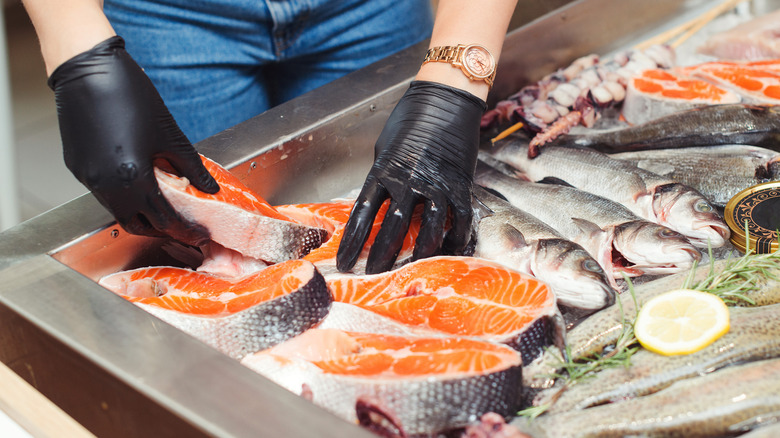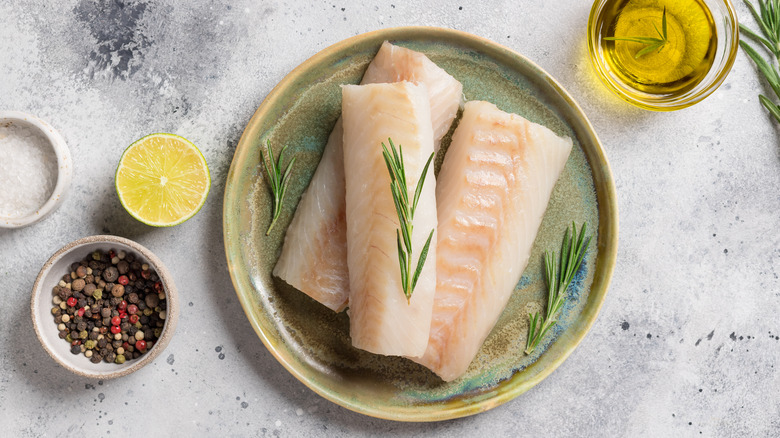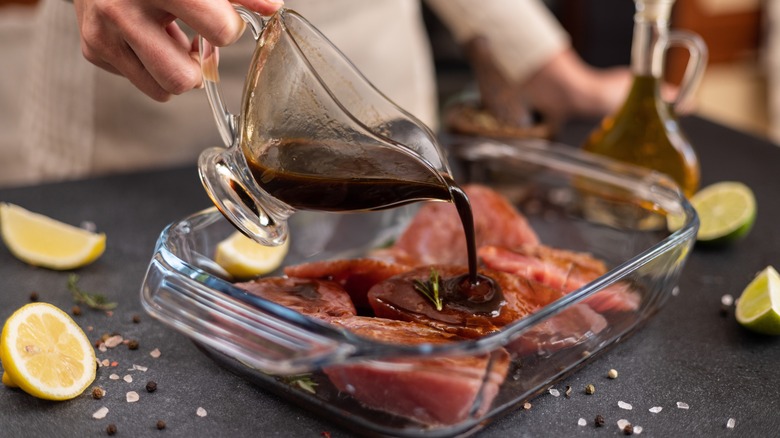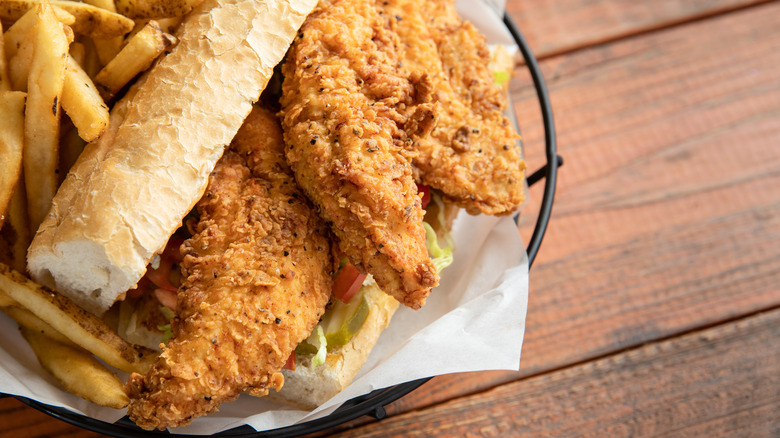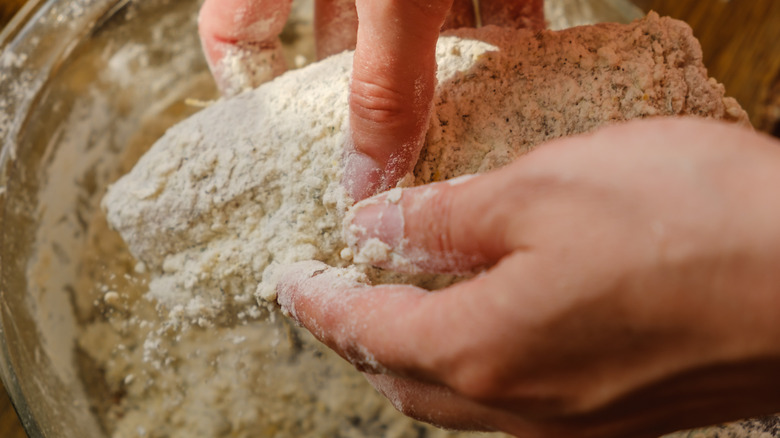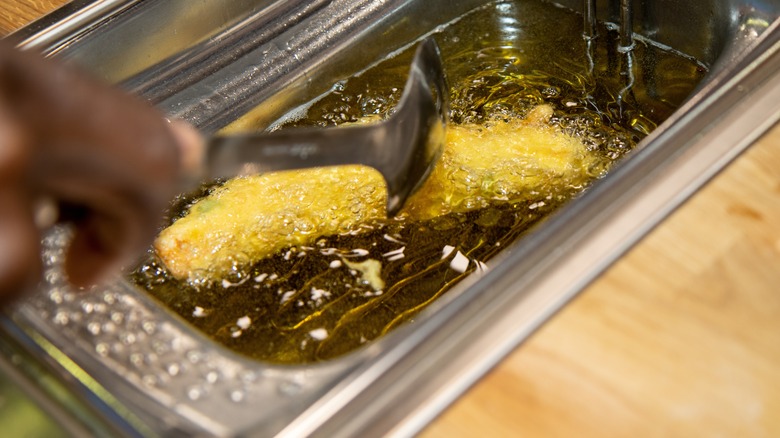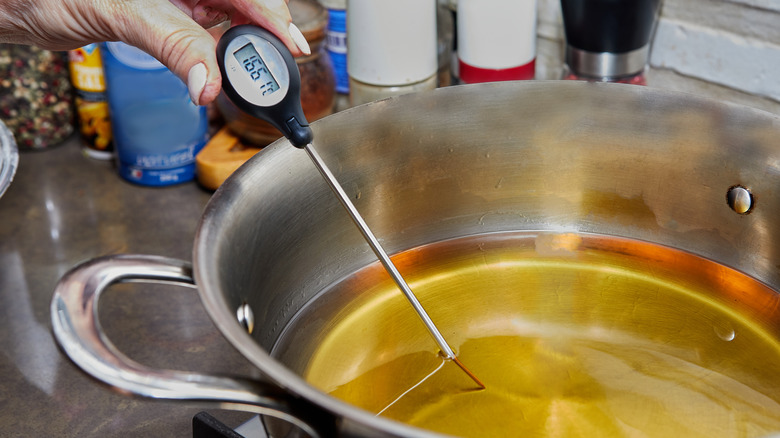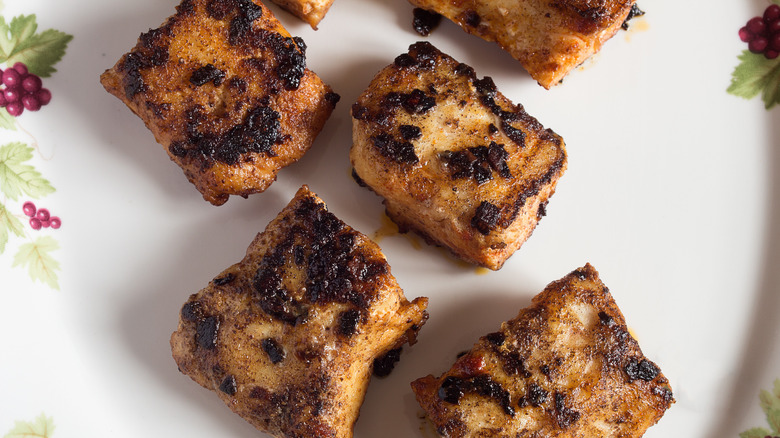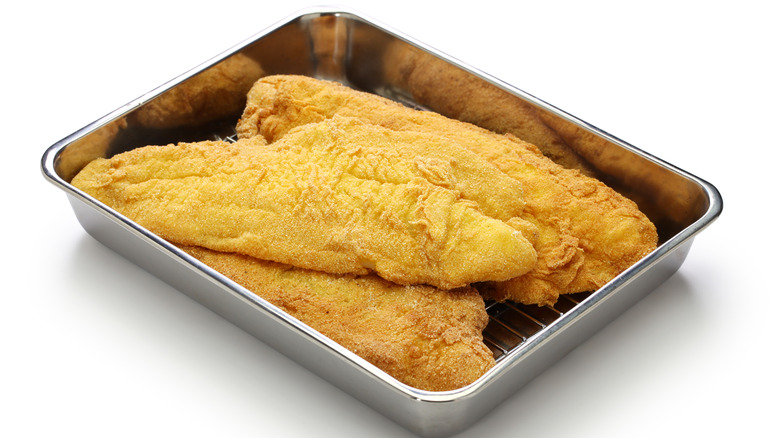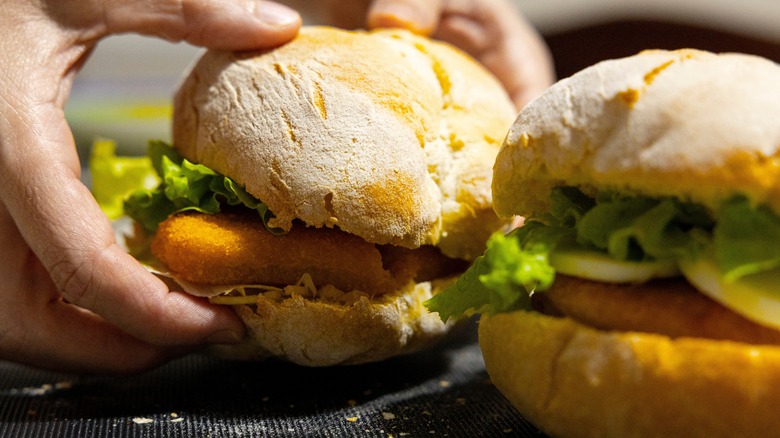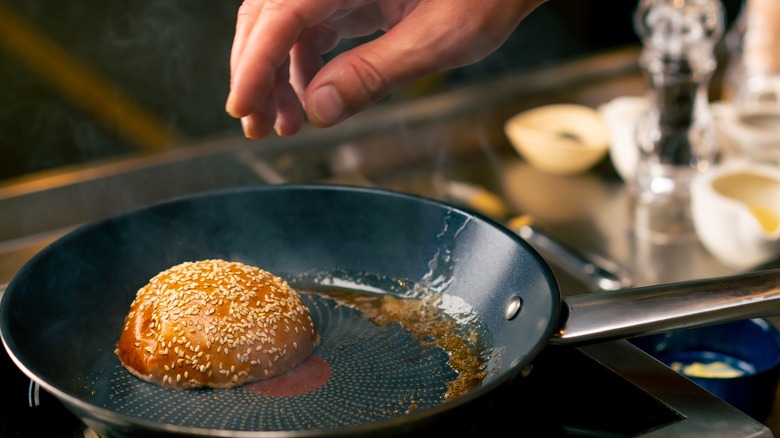Why Fish Sandwiches Always Taste Better At A Restaurant Vs At Home
Crispy, flaky, and flavorful, a fish sandwich can be absolutely divine if prepared properly. It's not the easiest dish to make at home though. There are many elements to consider, from getting the perfect crunch to keeping the interior tender and choosing the right condiments. It's a dish that many people don't even attempt to make at home. Instead, many turn to restaurants to get their fish sandwich fix.
If you've tried to master fish sandwiches yourself only to come up short when compared to your favorite restaurants, there could be several things going on. Chefs know that to make the best fish sandwiches, you need to choose the right fish, batter the fish so it won't fall apart, and get the oil temperature just right for a beautiful golden crust. Plus, chefs know which ingredients will take the sandwich from lackluster to lip-smacking good.
To help you achieve fish sandwich greatness, we spoke to several chefs and culinary experts to find out how they make top-quality fish sandwiches. This is their insight into why fish sandwiches always taste better at a restaurant than at home, along with some helpful tips on how you can master the dish.
Restaurants know that the type of fish you use matters
According to the experts, one of the biggest mistakes that home cooks make with fish sandwiches is choosing the wrong type of fish. Pick a fish that's too delicate and it may fall apart in the pan or deep fryer. Meatier fish will hold up better, but you don't want something too dense because it could make the sandwich tough. You also don't want something with a strong fishy taste because it could overpower the other flavors. Many chefs say the best fish for fried fillet sandwiches is firm white fish.
Gordon Drysdale, culinary director at Scoma's, says mild white fish are best for fish sandwiches. "At Scoma's, we use fresh flounder from the Gulf, but any local rock cod works great for the home cook — especially ling cod, if you can find it. That fish loves the fryer! These fish all share a juiciness that makes them perfect for sandwiches." In addition to being juicy, cod has a beautiful buttery flavor and is tender, but firm enough to hold up in the fryer. Other fish that work well in fish sandwiches include haddock, halibut, and mahi-mahi.
Top-notch restaurants don't use frozen fish
One major advantage that restaurants have over home cooks is they have access to the freshest catches of the day. While frozen fish may be cheaper and more readily accessible, most chefs will tell you that fresh fish makes a huge difference in the texture and flavor of your fish sandwich. In fact, many say not choosing fresh fish is one of the biggest mistakes people make when buying seafood. The quality of the fish is also key.
Rena Awada, owner and head chef at Healthy Fitness Meals, says that it's essential to use fresh, high-quality fish from a market or grocery store. Look for fish that are clean, bright, and shiny. If it smells fishy, it's probably not fresh. Also, don't be afraid to ask when the fish was caught and where it came from. "Overall, attention to detail and quality ingredients are key factors that make restaurant fish sandwiches stand out from homemade versions," Awada says.
Marinating the fish can take it to the next level
If you've ever wondered how restaurants make their fish sandwiches juicy and flavorful, Joe Bowab, CEO and founder of Lobster Anywhere, offered some insight. "Make sure that you marinate your fish before cooking to enhance flavor and so that the fish is more tender," Bowab says. White fish tends to be quite mild, which means it can also be slightly bland. A marinade featuring ingredients like oil, juice, herbs, and spices can impart extra flavors.
There are endless possibilities for fish marinades. If you want to add some brightness, consider olive oil, lemon, and herbs. For a tropical slant, try coconut oil, lime juice, and chili. Rena Awada suggests using soy sauce, honey, and garlic for salmon sandwiches.
One thing to be aware of though is that acidic ingredients can affect the texture of the fish. Acids break down the proteins in meat through a process called denaturation. Therefore, you don't want to marinate your fish for too long because this common mistake can make fish mushy. A good rule of thumb for fish sandwiches is to only marinate the fish for 15 to 30 minutes before cooking it.
Chefs match the type of fish to the batter
While the fish may be the main star of the fish sandwich, chefs know that the batter is just as important. "The main reason a fish sandwich is better in a restaurant than at home is because in restaurants we match the fish with the correct batter," said Chef Larry Kearns of Dahlia's Restaurant & Porch. When deciding on a batter, it helps to consider the texture of your fish. Firmer, thicker fish fare well with light, airy batters, while flakier fish can benefit from a grainier breading that helps protect the fish.
If you're using white fish that are slightly firm like cod or halibut fillets, a beer batter is ideal because it will give the fish a light crunch without overpowering the flavor or texture of the fish. Flakier fish like whiting taste great with a coarser crust to add texture to the softness of the fish. Kearns suggests using batter with cornstarch and cornmeal for whiting. Panko breadcrumbs can also give you extra crunch and bite that you don't typically get from a smooth beer batter.
The batter used at restaurants is always seasoned
Regardless of which batter you choose for your fish, nearly every expert we spoke to said that seasoning is the secret to a great fish sandwich. "In restaurants, we often use a specific blend of seasonings in our batter or breadcrumbs that enhances the fish's flavor without overpowering it," said Nic Vanderbeeken, executive chef at Apéritif. Some chefs season the batter and breading simply with salt and pepper, while others add dashes of paprika or garlic powder. The trick is to keep it balanced so that the flavor of the fish still shines through.
Gordon Drysdale also pointed out that where you add the seasoning can make a difference. For example, he dredges his fish in flour, dips it in egg, then coats it in panko breadcrumbs. However, he seasons the beaten eggs instead of the dry ingredients. "Seasoning the egg, as opposed to the flour or breadcrumbs, ensures that the seasoning is evenly dispersed (otherwise salt will settle to the bottom of either flour or crumbs and be useless)," he said.
Using the right equipment can make a huge difference
Restaurants not only have access to top-quality ingredients, but many also have top-of-the-line equipment. For example, most restaurants have deep fryers that can give fish a gorgeous golden, crunchy exterior. In addition, chefs use fillet knives for perfectly portioning fish fillets and fryer thermometers to maintain the correct temperature of the oil. They may even employ useful kitchen tools you haven't heard of like a fish turner, herb stripper, or fish spatula. How can you compete?
Kevin Ashton, culinary advisor at Restaurantji, says there are two tools that home cooks absolutely must have if they want to create restaurant-worthy fish sandwiches: a good pan and a thermometer. "A non-stick pan or cast-iron skillet ensures even cooking and is a perfect sear for crispy fish. Use a deep-fry thermometer to help maintain the ideal temperature until you achieve a crispy golden coating," he said. Beyond that, you don't need anything too fancy to create a great fish sandwich, although a deep fryer can certainly help.
Getting the temperature of the oil right is crucial for crisp
There's nothing worse than biting into a fish sandwich and getting a mouthful of mush. After all, crispiness is one of the things that makes fish sandwiches so great. If you just can't seem to get the crunch factor down, the temperature of your oil may be the problem. "I would suspect that a not-hot-enough fryer has sabotaged a lot of at-home sandwiches," Gordon Drysdale said. "Getting the heat right so that the coating is crispy when the fish itself is cooked is the goal."
Ideally, you want your oil to be between 350 and 375 F to ensure that your fish cooks all the way through and you get that lovely crust. This is where an oil thermometer comes in handy. Don't have one? Try Rachael Ray's trick for testing if the oil is hot enough by placing the handle of a wooden spoon in the oil. If bubbles start appearing, your oil is probably hot enough. Be sure not to overcrowd the pan, as this can prevent the fish from crisping up. If you're frying your fish in batches, let the oil come back up to temperature between each round.
Overcooking the fish can result in disaster
While soggy fish is the bane of many home cooks, overcooked fish isn't any better. "The most basic mistake that home cooks should avoid is overcooking the fish. This will give little flavor and a very dry sandwich," said Eric Sornoso, co-founder of Mealfan. A digital thermometer can be a godsend for preventing scorched fish. You can use it to check the oil and the internal temperature of the fish. Fish should be cooked to about 145 F inside.
Chefs also know that the type of oil you use matters. That's because different oils have varying smoke points. The best oils for deep frying fish are canola oil and vegetable oil because they have high smoke points. These oils can reach temperatures of roughly 375 to 450 F without burning or smoking. That will give your fish the crunch it needs, while still keeping it moist inside. Avoid butter, extra virgin olive oil, and coconut oil. These cooking fats have low smoke points, meaning they can leave your fish with an acrid burnt taste.
Chefs often rest the fish before assembling the sandwich
Once your fish is nicely fried and crisped up, the first thing you might want to do is slap it on a bun with some sauce and eat it while it's hot. However, many chefs let their fish rest before assembling the sandwich. There are several reasons for this. First, resting allows the heat to disperse evenly throughout the meat. It can also prevent your sandwich from getting soggy and allow the flavors to meld together for a more comprehensive bite.
There is some debate over the best way to drain fried food. Some say a wire rack is the best way to go because it allows steam to escape and air to circulate around the fried items. Others say that a plate or bowl lined with paper towels is best because the paper towels wick away oil that otherwise might soak into the food. You can also place your fried fish on a wire rack and keep it warm in the oven. Just be sure to keep the temperature low so that your fish doesn't overcook and become dried out.
The right type of bread is also a key factor
Given that bread is the packaging that holds a fish sandwich together, it makes sense that this is another area that chefs don't overlook. "A good sandwich starts with the right foundation, and a toasted brioche or ciabatta can make all the difference. The heat and texture contrast between the crispy fish and the soft, slightly warm bun is key to a restaurant-quality sandwich," Nic Vanderbeeken
Ideally, you want your buns to be pillowy and soft, but hefty enough to hold together all the elements. You also want your bread to compliment the crispy fish instead of detracting from it. Hard, crusty breads are tricky because they can make the sandwich too dense and difficult to eat. Slices of white sandwich bread can get soggy and fall apart thanks to the weight of the fish and condiments. Look for soft bread with a bit of body like brioche, potato rolls, or Kaiser rolls. Hamburger buns can also work well, provided they're large enough to encompass the fish.
Professional cooks know exactly how and where to toast the bun
Another factor that sets restaurant fish sandwiches apart from many home-cooked versions is the way the bun is prepared. "You should never skip buttering or toasting the bun because it leaves it soggy. You need a well-prepped bun to add texture and flavor to your sandwich," said Kevin Ashton. The butter not only imparts richness and flavor but also creates a protective barrier against the wet toppings. The toasting also prevents the bun from getting overly moist and adds structure to the sandwich.
According to many chefs, there is an art to getting the buttering and toasting just right. Gordon Drysdale recommends buttering just the inside of the bread and then griddling it. You could toast the entire bun, but then you run the risk of it becoming too crusty and dry. Adding butter to both sides is a definite no because it can saturate the bread, making it greasy. In addition, too much butter can overwhelm the flavors of the fish and toppings. Remember — the perfect fish sandwich is all about balance.
A sandwich press is a well-kept restaurant secret
Who says sandwich presses are just for paninis? Chefs know that this handy kitchen tool has multiple uses, one of which can be making fantastic fish sandwiches. "You can try using a panini press to get that crispy texture on the outside of your sandwich. This can also help to lightly toast the bread and melt any cheese or toppings inside," Rena Awada told Chowhound. She added that it also makes it easier to cook the fish evenly and keep it compact.
You can even consider cooking your fish in a panini press if you prefer grilled fish over deep-fried fillets. All you need to do is season your fish, lightly oil the grates, throw your fish in the press, and you can have delicious fish in just minutes. This method can save you time and the hassle of having to deal with ultra-hot oil and the inevitable mess that comes with it. Just to be clear, though, you'll be missing out on that crunch that many people crave in a classic fish sandwich.
Sauces and condiments take restaurant fish sandwiches to the next level
What condiments do you add to your fish sandwiches? If you're like many home chefs, you probably go classic with toppings like mayo, lettuce, and maybe a slice of cheese. However, ask chefs what condiments they use, and you'll likely get an array of answers. That's because chefs know that interesting flavor and texture combos can take a fish sandwich to the next level.
Some of the unique toppings the experts we spoke to use include flavor-packed sauces like freshly made tartar sauce, tangy remoulade, and spicy aioli. Pickled veggies, mango salsa, fried capers, and fennel slaw can add crunch, flavor, and color. Many chefs also incorporate citrus to balance out the richness of the fried fish or add fresh herbs for brightness.
The only thing to keep in mind with the toppings is you don't want to go overboard and drown out the flavor of the fish. As Rena Awada said, "While a sandwich is well known for its layers of ingredients, it's important to let the fish shine as the star of the dish. Don't be afraid to experiment with different toppings and sauces, but remember to keep them balanced."

